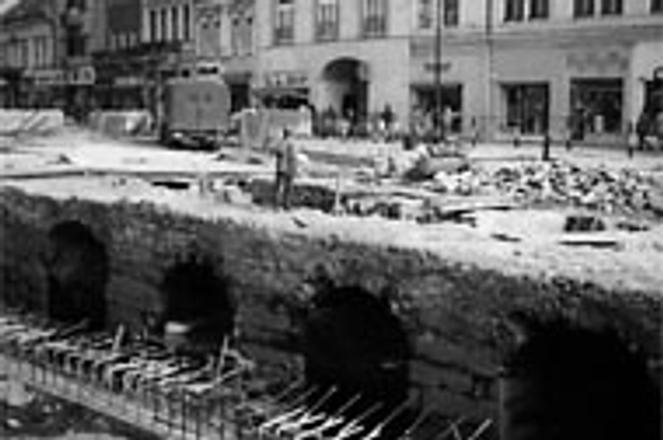Treasure below. An elaborate medieval fortification was found under the streets of Košice a year and a half ago.Reid Deaver
It has always been known that there was something under the streets of Košice. But it wasn't until the jack hammers started pounding the pavement in between the Slovan Hotel and St. Elizabeth's Cathedral a year and a half ago that people found out for sure that an elaborate medieval fortification of the city lay intact - the biggest and most important archeological find in Slovakia.
Unveiled underneath are five city gates which provided access in and out of the city. Archeologists uncovered the foundation of a lower gate which was destroyed in 1827, four walls which archeologists describe as four belts of fortification, a barbican and a bridge.
The fortification system seems to represent four time periods. The first wall was built around 1260 - 1290, the second from 1392 - 1420, the third around 1460 and the most recent outer fortification from 1560 - 1600.
"The history of Košice is largely uknown, and there are a lot of questions we would like to answer," said Jozef Duchoň, director of the Historical Preservation Institute (Pamiatkovy ústav). "Though this site will help, it will take time to form a picture."
The digging is expected to continue until May 1, when a museum should be opened. Košice Mayor Rudolf Shuster is keen on creating a tourist attraction and is willing to have the city finance the 30 million Sk in order to create the museum.
If you build it, they will come
The sight will have a reinforced concrete roof. There had been discussions of putting a glass surface over the ruins but due to bad experiences in both Vienna and Verona due to damage caused by a wet climate, it was decided that the best way would be an underground museum.
City officials are currently discussing if it is possible to create holes in the concrete roof above so that people could look down at parts of the sight, but no final decision has been made.
The fact that a concrete slab is going to encompass the 56 meter long site hasn't been welcomed with open arms by Duchoň. He said that working on the site will be like working in a mine.
When it is all finished, it will be possible to walk through and see the different fortification belts in close detail. Of interest at the site is the fact that the defense of the city relied on barbicans, small fortresses built in front of the city walls which housed cannons. It was important that cannons be strategically located and have enough space to be flexible in order to protect the city from invaders.
As military technology became more sophisticated, barbicans were needed because the earlier built walls weren't strong enough to protect the city. The barbican uncovered in the dig was made of brick and stone, and is seven meters thick and thought to have been built around 1460.
What makes this barbican special is that a space was made on its back side so that a cannon could fire at the city's own walls. This enabled them to gun down attackers who had gotten behind the barbican. The only downside as Duchoň pointed out was that if invaders captured the barbican it could be used against the very city it was built to protect.
Evidence suggests that an Italian architecht named Aristotele Fioravante (1466 - 80) was invited by King Matyás Korvín (1458 - 1490) to design and build the fortification. It is commonly believed that Fioravante also travelled to Moscow and worked on the Kremlin. The biggest surprise was that archeologists found a bridge made of brick and stone which was 24 meters long and in good condition.
Nobody expected it would be so well preserved because for over 100 years the trams had been running over the area. The fortification system must have been well built because when Korvín died in 1490, Košice was attacked the following year in 1491 by the Polish heir to the throne, Jon Albert. His attack failed.
Author: Reid Deaver


